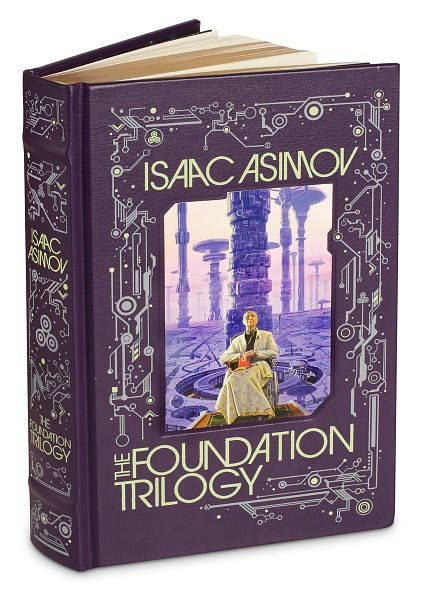In the vast cosmos of science fiction literature, few works have sparked as much fascination and intellectual curiosity as Isaac Asimov’s Foundation Trilogy. Spanning centuries of imagined history and weaving a tapestry of science, politics, and psychology, the trilogy invites readers to explore the rise and fall of civilizations through the lens of psychohistory. This review delves into the intricate layers of Asimov’s seminal series, unpacking its themes, narrative structure, and enduring impact on the genre. “Decoding Civilization” offers a thoughtful examination of how the Foundation Trilogy not only envisions a distant future but also reflects timeless questions about human nature and societal evolution.
Exploring the Intricacies of asimov’s World Building and the Futuristic Scope of the Foundation Trilogy

Isaac Asimov’s narrative genius lies not merely in his compelling characters but in the vast, meticulously crafted universe that operates with its own internal logic and historical layering. This sprawling cosmos spans millennia, laced with political intrigues, social upheavals, and scientific advancements that reflect both the possibilities and perils of humanity’s future. His use of psychohistory as a speculative science-blending mathematics, sociology, and history-introduces a unique mechanism for predicting societal shifts, which challenges conventional notions of free will and destiny. The Foundation Trilogy’s settings transition from the decaying Galactic Empire to the budding Foundation, showcasing a spectrum of civilizations each grappling with the forces of entropy and renewal.
What stands out is how Asimov’s world building cleverly anticipates future technologies and societal structures without succumbing to excessive technical jargon. From the Encyclopedia Galactica serving as a beacon of preserved knowledge to the political machinations within the elusive Second Foundation, the trilogy immerses readers in a culture both alien and eerily familiar. Consider the following thematic elements that Asimov explores:
- Decentralization of Power: The pivot from empire to foundation highlights the fragility and adaptability of civilizations.
- Role of Knowledge: Knowledge is portrayed as the ultimate currency, shaping societal trajectories.
- Human Agency vs Determinism: The tension between mathematical predictions and individual actions fuels much of the plot’s suspense.
| Element | Characteristic | Impact on Civilization |
|---|---|---|
| Psychohistory | Predictive Science | Guides societal planning and crisis intervention |
| Galactic Empire | Decadent and Fragmented | Represents decline and stagnation |
| Foundation | Beacon of Knowledge | Symbolizes hope and rebirth |
| Second Foundation | Secretive Manipulators | Steers destiny from behind the scenes |
Analyzing the Philosophical Themes Behind Civilization’s Rise and fall in Asimov’s Narrative

At the heart of Asimov’s narrative lies a profound meditation on the cyclical nature of history and the fragile constructs of societal order. The Foundation Trilogy deftly explores the tension between determinism and free will, weaving a tapestry where human agency is both empowered and constrained by the mathematical precision of psychohistory.Civilization emerges not as a static monument but as an evolving organism, susceptible to the decay of ignorance, complacency, and the insidious rise of entropy. This philosophical underpinning invites readers to question whether the unavoidable decline of empires is a result of fate or a reflection of humanity’s collective choices.
Within this framework, Asimov subtly interrogates the roles of leadership, knowledge, and faith in shaping civilization’s trajectory. Key themes include:
- The fragility of centralized power and how reliance on singular authorities can hasten decline.
- The tension between scientific rationalism and myth-making as tools for societal cohesion.
- The ethical dimensions of prediction and manipulation embedded in the psychohistorical premise.
These elements converge to create a rich philosophical dialog on whether the foundation of a society rests more firmly on empirical knowledge or on the narratives it tells itself to endure through chaos.
| Theme | Philosophical Question | Implication |
|---|---|---|
| Determinism vs Free Will | Are historical outcomes preordained? | Challenges the concept of human agency |
| Knowledge as Power | Can science alone preserve civilization? | Raises questions about overreliance on logic |
| Myth and Faith | Do myths provide necessary social bonds? | Highlights the importance of shared beliefs |
The Role of Psychohistory in Shaping the Trilogy’s Unique Approach to Predicting Societal Change

At the heart of the trilogy lies an ingenious concept-a science conceived to predict the collective future of humanity by analyzing the psychology of enormous populations rather than individuals. This groundbreaking approach transforms historical cycles from arbitrary events into decipherable patterns. By intertwining statistics with human psychology, it creates a map of societal momentum, enabling the prediction of vast social shifts and the mitigation of chaos during collapse.The idea thrives on the assumption that while individual actions might potentially be erratic, aggregated behaviors follow discernible trends, carving a new path in speculative thought.
- Mass Behavior as Data – Treating billions as a single entity rather than isolated units.
- Statistical Certainty – Using probabilistic models to forecast possible futures.
- Intervention and Control – Guiding societies subtly to prevent prolonged dark ages.
This union of psychology and mathematics elevates the narrative beyond typical sci-fi fare,making psychohistory itself a character-one that shapes destiny with patient,calculated precision. Its unique methodology challenges readers to ponder: Can free will coexist with deterministic models on a cosmic scale? This tension imbues the series with a philosophical richness, exploring the balance between chaos and order through a visionary lens.
| Aspect | Traditional History | Psychohistory |
|---|---|---|
| Focus | Individual actions | Mass societal trends |
| Predictive Power | Uncertain | Probabilistic but reliable over large scales |
| Role in Story | backdrop | Driver of plot and ideology |
Character Development and Their symbolic Representations Throughout the foundation Saga

Isaac Asimov’s Foundation saga isn’t just an epic chronicle of galactic politics and the rise and fall of civilizations; it’s a tapestry of characters whose very essence embodies the abstract forces shaping humanity’s destiny. Take hari Seldon, as a notable example, whose role transcends that of a mere protagonist-he symbolizes the power of knowledge and foresight. his psychohistory stands as a metaphor for the rationality and inevitability behind societal evolution, guiding the seemingly chaotic universe toward order. Conversely, figures like Salvor Hardin represent the pragmatic, often ruthless pragmatism necessary for survival, emphasizing that wisdom alone isn’t enough without shrewd action.
Beyond these central characters, the saga leverages subtle symbolic representations through its supporting cast, enriching the narrative’s thematic complexity. For example:
- Hober Mallow embodies calculated diplomacy and the intersection of commerce with power, illustrating how economic forces can underpin political change.
- Ebling Mis, a tragic figure, symbolizes the peril of obsession and the limitations of scientific pursuit when divorced from ethical considerations.
- Bayta Darell stands as an emblem of human intuition and courage, reminding us of the unpredictable variables that challenge sweeping predictive theories.
| Character | Symbolic Role | Key Trait |
|---|---|---|
| Hari seldon | Foresight & Rationality | Calculated Vision |
| Salvor Hardin | Pragmatic Survival | Strategic Shrewdness |
| hober Mallow | Economic Power | Diplomatic Cunning |
| Ebling Mis | Obsession & Limitations | Tragic Genius |
| Bayta Darell | Human Intuition | Courage & Instinct |
Examining the Narrative Structure and How It Enhances the Pacing and Engagement of the Series

The Foundation trilogy masterfully employs a non-linear narrative structure that intertwines multiple timelines and perspectives, creating a tapestry of stories that feel both expansive and intimately connected. Rather than following a traditional chronological path, Asimov opts for episodic leaps across decades, allowing key moments in the rise and fall of civilizations to unfold in distinct vignettes. this approach not only sustains momentum but also invites readers to piece together the grand puzzle of galactic history, enhancing engagement through active intellectual participation. The shifts in focal characters and settings keep the series fresh and dynamic, avoiding stagnation and encouraging readers to explore recurring themes from varying angles.
Within this mosaic, pacing is deliberately modulated; moments of intricate political dialogue and theoretical exposition are balanced by fast-moving crises and confrontations. This rythm is crucial-
- Episodes are concise but dense, packing philosophical depth into manageable segments.
- Transitions between story arcs enhance suspense, with each closure hinting at forthcoming upheavals.
- Character development is strategically spaced, allowing shifts in allegiance and ideology to resonate throughout the trilogy.
Below is a simple breakdown of narrative pacing by book:
| Book | Key Narrative Style | Pacing Effect |
|---|---|---|
| Foundation | Interlinked Stories | Quick shifts with strategic cliffhangers |
| Foundation and empire | Expanded political tension | Controlled suspense with rising stakes |
| Second Foundation | Psychological intrigue | Slow burn leading to explosive reveals |
impact of Asimov’s Trilogy on Science Fiction Genre and Its Enduring Influence on Popular Culture
Isaac Asimov’s trilogy revolutionized the science fiction landscape by weaving together complex themes of psychology, sociology, and futurism with a narrative scale rarely attempted before. The trilogy’s exploration of psychohistory-a fictional science that blends history, sociology, and mathematical statistics to predict the future-introduced a fresh intellectual depth to the genre. Its influence can be seen in the rise of speculative fiction that embraces grand ideas about civilization’s evolution, governance, and the cyclical nature of history. Writers and creators have drawn inspiration from Asimov’s vision, adopting his method of embedding robust scientific concepts within expansive, character-driven sagas.
Beyond literature, the trilogy’s impact resonates throughout popular culture, informing films, television, and even video games. It established key tropes, such as the benevolent yet inscrutable guide figure, and the long-view approach to storytelling that synthesizes macrocosmic societal shifts with personal drama. Asimov’s foundation has been a creative touchstone, ushering in narratives that pulse with a sense of inevitability and human resilience. Elements of the trilogy continue to appear in:
- Blockbuster sci-fi franchises exploring interstellar empires and socio-political intrigue
- Philosophical debates on history’s direction and free will in futuristic settings
- Video games incorporating strategic foresight and empire-building mechanics
| Aspect | Influence | Examples |
|---|---|---|
| Narrative Scale | Multi-generational storytelling | Star Wars, Dune |
| Science Concepts | Psychohistory & predictive sociology | The Expanse, Altered Carbon |
| Philosophical Themes | determinism vs free will | Westworld, Blade Runner 2049 |
A critical Look at the Ethical Dilemmas and Moral Questions Presented in the Storyline
Isaac Asimov’s Foundation Trilogy masterfully intertwines a vast galactic saga with intimate ethical quandaries that challenge readers to examine the cost of progress and the meaning of leadership. At its core, the narrative grapples with the tension between determinism and free will: can the course of history truly be predicted and manipulated without compromising individual autonomy? The psychohistorian Hari Seldon’s grand plan to shorten the inevitable collapse of civilization exposes the uncomfortable reality that some sacrifices-both human and cultural-may be deemed necessary for the greater good. This raises profound questions about morality on a mass scale: Is it justifiable to orchestrate events that sacrifice the few for the survival of many?
- The ethical cost of manipulation: How far is to far when controlling societies?
- Authority versus autonomy: The balance between collective destiny and personal freedom.
- The role of prophecy and determinism: Can humans transcend predetermined futures?
Moreover, the trilogy presents a captivating canvas on leadership ethics, examining the burden and consequences of wielding power under the guise of scientific inevitability. Characters frequently enough face moral impasses where pragmatic decision-making clashes with idealistic values-as a notable example, when individuals or groups must decide between survival through deception or upholding transparency at the risk of chaos. This duality mirrors contemporary debates about governance, transparency, and ethical stewardship in times of crisis, making the Foundation Trilogy not only a tale of distant futures but also a timeless reflection on human values.
| Ethical Dilemma | Central Question | Representative Character |
|---|---|---|
| Mass manipulation | Is guided destiny a form of benevolent control? | Hari Seldon |
| Moral sacrifice | do ends justify tragic means? | Salvor Hardin |
| transparency vs Secrecy | Should truth be sacrificed for stability? | Bel Riose |
How Decoding Civilization Offers Fresh Perspectives and new Interpretations of Asimov’s Masterpiece
Exploring the intricate layers of Asimov’s magnum opus through the lens of decoding civilization sheds new light on the subtle interplay between sociology, politics, and human behavior embedded within the narrative. This fresh approach reveals how the collapse and rebirth of the Galactic Empire mirror the cyclical nature of real-world civilizations, suggesting that Asimov’s work is not only a science fiction epic but also a profound commentary on historical inevitabilities. By dissecting the sociopolitical structures and psychohistorical predictions, readers gain a deeper appreciation for how cultures evolve under pressure and how leadership emerges amidst chaos.
Moreover,this outlook invites us to rethink the traditional hero’s journey format commonly attributed to the trilogy. Rather of focusing solely on individual protagonists, the analysis highlights the collective influence of social forces and the role of knowledge preservation.Consider the following key themes unraveled through decoding:
- Collective intelligence as a driver of societal resilience
- Decay and renewal as constants in human history
- Predictive sociology as a scientific lens on future civilizations
| Theme | Traditional View | Decoding Civilization View |
|---|---|---|
| Leadership | Heroic individuals | Social dynamics & collective roles |
| Civilizational Collapse | Random chaos | Historical cycles & inevitability |
| Knowledge Preservation | Scientific progress | Cultural continuity & survival strategy |
Recommendations for Readers: Who Will Most Benefit from Diving Into This Thought-Provoking Series
Readers with a fascination for complex world-building and narratives that intertwine history, politics, and philosophy will find this trilogy especially rewarding. Those who appreciate stories that challenge conventional storytelling-where the emphasis lies not just on characters but on expansive ideas about societal evolution-will be captivated by Asimov’s grand vision. If you’re intrigued by the notion of humanity’s trajectory mapped through the lens of science and predictive social sciences, this series acts as a masterclass in speculative thought.
additionally, fans of intellectual fiction who enjoy peeling back the layers of human behavior amid monumental change will benefit immensely. Whether you are a student of history seeking a new perspective, a science fiction enthusiast drawn to cerebral narratives, or simply a curious mind yearning to unravel the interplay between destiny and free will, this trilogy offers a rich tapestry to explore. For quick reference, here’s who this series resonates with:
| Type of Reader | Why They’ll Benefit |
|---|---|
| History Buffs | Appreciate the cyclical depiction of civilizations |
| Philosophy Enthusiasts | Explore ethical and societal dilemmas |
| Sci-Fi Fans | Engage with pioneering speculative concepts |
| Political Thinkers | Analyze power dynamics on a cosmic scale |
| Curious Minds | Experience layered storytelling with depth |
Visualizing Asimov’s Universe Through Decoding Civilization’s Insightful and Imaginative interpretations
The vastness of Asimov’s universe is not merely a backdrop for his narrative, but a meticulously crafted tapestry weaving together elements of history, sociology, and speculative science. Through his visionary approach, readers are invited to explore civilization not just as a setting, but as a living, evolving organism. the Foundation Trilogy showcases how cultural, political, and technological forces interact in unpredictable yet insightful ways-each interpretation revealing layers of societal reflection wrapped in imaginative expression.
Visualizing this intricate cosmos, one can discern recurring themes that speak to humanity’s eternal struggles and triumphs. Asimov’s foresight champions the power of knowledge, the delicate balance of power structures, and the resilience of collective human will. Below is a brief snapshot illustrating key thematic intersections within his universe:
| Theme | Insight | Imaginative Element |
|---|---|---|
| Psychohistory | Predictive social science | Mathematical modeling of future events |
| Decay and Renewal | Rise and fall of empires | Galactic empires in decline |
| Human Agency | Individual versus destiny | Calculated manipulation of history |
- Contrast of deterministic fate with the unpredictable nuances of human choices.
- Exploration of social engineering as both a tool and a threat.
- The portrayal of knowledge as a double-edged sword, shaping civilizations across millennia.
The author Behind Decoding Civilization and Their Approach to Analyzing Asimov’s Timeless Trilogy
At the heart of this insightful analysis is an author who approaches Asimov’s magnum opus not just as a science fiction saga, but as a profound exploration of societal evolution and human psychology. With a background steeped in historical theory and cultural studies, the writer deftly navigates the complex layers of the Foundation Trilogy, illuminating how Asimov wove predictive social science-psychohistory-into the very fabric of his narrative. Their approach is methodical yet imaginative, inviting readers to consider the trilogy beyond its futuristic settings and appreciate it as a mirror reflecting the cyclical nature of civilizations throughout history.
Employing a blend of literary critique and philosophical inquiry, the author builds the review around several key thematic pillars:
- The Rise and Fall of Empires: A comparative lens linking galactic empires to historical parallels on Earth
- Psychohistory’s Ethical Dimensions: questioning the morality of manipulating societal fate
- Individual vs. collective agency: Examining the tension between personal ambition and societal destiny
- Technological Progress and Cultural Decay: How innovation shapes, and sometimes undermines, civilization itself
| Aspect | Author’s Perspective | notable Highlight from Trilogy |
|---|---|---|
| Social Dynamics | viewed as cyclical, not linear | The Seldon Crisis as a resetting point |
| philosophical inquiry | Moral ambiguity in prediction | Hari Seldon’s dilemma on free will |
| Character Roles | Symbols of broader societal forces | Salvor Hardin’s pragmatic governance |
In unraveling the layers of Asimov’s Foundation Trilogy, we find more than just a tale of futuristic empires and psychohistorical predictions; we encounter a profound meditation on the cyclical nature of history and the power of knowledge to shape destiny. Whether you are a seasoned science fiction aficionado or a curious newcomer, this trilogy offers fertile ground for reflection on the interplay between individual agency and grand societal forces. As we close the pages of this review, the echoes of Asimov’s visionary saga linger-a reminder that in the vast expanse of civilization, the quest to decode our collective future is as relevant today as it was when first imagined.










